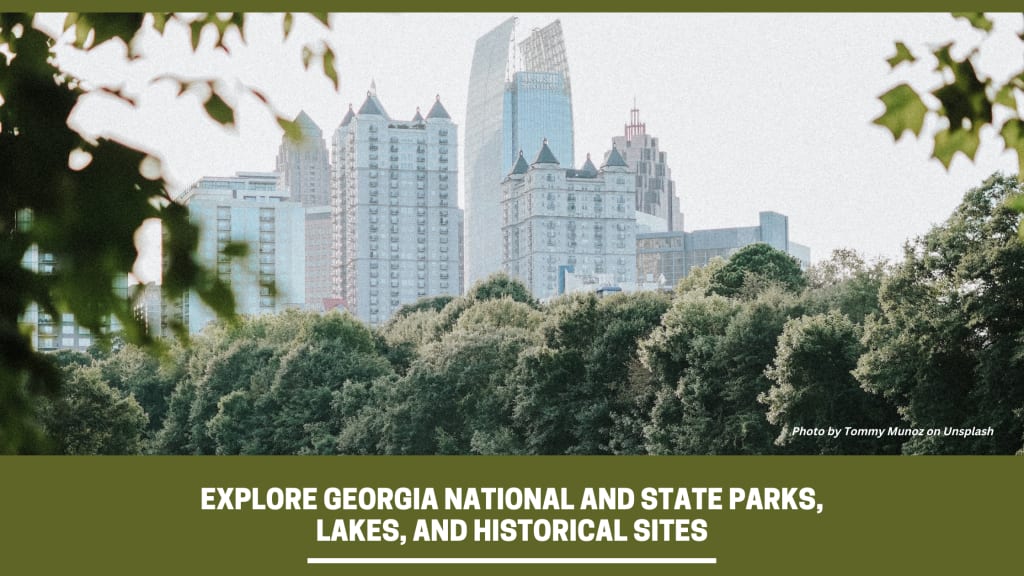Explore Georgia National and State Parks, Lakes, and Historical Sites
The Appalachian Trail begins in Fannin County on the summit of Springer Mountain, where you can begin the 2,000-mile journey up to Mount Katahdin in Maine. Interested? So, let's get started.

Georgia, the final and southernmost of the original Thirteen Colonies, has over 2,000 historic sites on the National Register of Historic Places and nearly 50 national historic landmarks. Every year, over 7 million people visit Georgia state historic sites. In addition to 11 national parks, the state has three national heritage areas, one national natural landmark, and two national trails. Every year, hikers and nature lovers flock to the Blue Ridge Mountains, which are part of the Appalachian Mountain system.
The Appalachian Trail begins in Fannin County on the summit of Springer Mountain, where you can begin the 2,000-mile journey up to Mount Katahdin in Maine. Interested? So, let's get started.
National Parks & Historic Sites
Andersonville National Historic Site
During the Civil War, the Camp Sumter military prison at Andersonville was one of the largest Confederate military prisons. More than 45,000 Union soldiers were imprisoned here during the prison's 14-month existence. Almost 13,000 of them died here. Today, Andersonville National Historic Site serves as a memorial to all American POWs throughout the country's history.
Appalachian National Scenic Trail
The Appalachian Trail is a 2,180+ mile long public footpath that traverses the Appalachian Mountains' scenic, wooded, pastoral, wild, and culturally significant lands. The Appalachian Trail, which was conceived in 1921, built by private citizens, and completed in 1937, is now managed by the National Park Service, US Forest Service, Appalachian Trail Conservancy, numerous state agencies, and thousands of volunteers.
Arabia Mountain National Heritage Area
Granite monadnocks have stood guard over Georgia's rivers and forests for millions of years. The Arabia Mountain National Heritage Area was established to protect and promote these outcrops and the surrounding region as a recreational wonder and national treasure.
Augusta Canal National Heritage Area
The Augusta Canal was instrumental in bringing the Industrial Revolution to the American South. The canal, which was built in 1845 as a source of power, water, and transportation, is the only fully intact American industrial canal still in use today. The first mills opened in 1847, followed by the massive Confederate Powder Works during the Civil War and many more industries in the later decades of the nineteenth century.
Chattahoochee River National Recreation Area
Today, the river valley entices us for a variety of reasons. Enjoy nature's display by going for a solitary walk, rafting leisurely through the rocky shoals with friends, fishing the misty waters as the sun rises, or having a picnic on a Sunday afternoon. Get outside and explore the Chattahoochee River National Recreation Area like you've never seen it before.
Chickamauga & Chattanooga National Military Park
Union and Confederate forces fought for control of Chattanooga, also known as the "Gateway to the Deep South," in 1863. It is one of the most prominent historic parks in Georgia. In September, the Confederates won at nearby Chickamauga. However, renewed fighting in Chattanooga that November resulted in Union troops winning and taking control of the city.
Cumberland Island National Seashore
Cumberland Island, Georgia's largest and southernmost barrier island, is accessible from St Marys. Here, pristine maritime forests, undeveloped beaches, and vast marshes tell the tales of both man and nature. There were Native Americans, missionaries, enslaved African Americans, and wealthy industrialists all walking here. Cumberland Island also has over 9,800 acres of wilderness designated by Congress.
Fort Frederica National Monument
When Spanish and British forces clashed on St. Simons Island in 1742, Georgia's fate was sealed. The troops of Fort Frederica defeated the Spanish, ensuring Georgia's future as a British colony. The National Park Service now protects the archaeological remnants of Frederica.
Fort Pulaski National Monument
Masonry fortifications were the primary defence of the United States against foreign enemies for much of the nineteenth century. During the Civil War, however, new technology demonstrated its superiority to these forts. The Union army used rifled cannon to force the surrender of the Confederate garrison at Fort Pulaski. The siege was a watershed moment in military science and invention history.
Gullah/Geechee Cultural Heritage Corridor
The Gullah Geechee Cultural Heritage Corridor, designated by Congress in 2006, runs from Wilmington, North Carolina to Jacksonville, Florida. It is home to one of America's most distinct cultures, shaped by captive Africans brought to the southern United States from West Africa and carried on by their descendants.
Jimmy Carter National Historic Site
Few US presidents have had such strong ties to the communities in which they were born and raised. Plains, Georgia's rural southern culture, which revolves around farming, church, and school, had a large influence on shaping the character and political policies of the 39th President of the United States.
Kennesaw Mountain National Battlefield Park
Kennesaw Mountain National Battlefield Park is a 2,965-acre National Battlefield that preserves an Atlanta Campaign Civil War battleground. From June 19 to July 2, 1864, opposing forces manoeuvred and fought here. Kennesaw Mountain is best known as a Civil War battlefield, but it has a much richer history.
Martin Luther King, Jr. National Historical Park
A young boy grows up during a period of segregation... Destiny propels a dreamer to the forefront of the modern civil rights movement... Martin Luther King, Jr. was present. Come hear his story and see where he grew up and played as a child. In the church where he moved hearts and minds, you can walk in his footsteps and hear his voice. Marvel at how he was an instrument for social change.
Ocmulgee National Monument
Ocmulgee National Monument welcomes you. This park is an American Indian prehistoric site. During the Paleo-Indian period, American Indians came here to hunt Ice Age mammals. For thousands of years, many different American Indian cultures occupied this land. The Mississippian Period began around 900 CE. They built mounds for their elite, which are still standing today.
Trail of Tears National Historic Trail
Remember and honour the Cherokee people, who were forcibly removed from their homelands in Georgia, Alabama, and Tennessee to live in Indian Territory, now Oklahoma. In 1838-1839, they travelled by foot, horse, wagon, or steamboat.
About the Creator
Amit Kumar
Full-time thinker & part-time writer...
Enjoyed the story? Support the Creator.
Subscribe for free to receive all their stories in your feed. You could also pledge your support or give them a one-off tip, letting them know you appreciate their work.






Comments
There are no comments for this story
Be the first to respond and start the conversation.